
Magento Content Staging: Troubleshooting Common Issues
Are you tired of managing content updates on your ecommerce? Magento Content Staging enables smooth scheduling and management of content updates. The feature allows store owners to create and preview the changes from the backend panel.
This article will help you discover how content staging can enhance ecommerce.
Key Takeaways
-
Discover the key features of how content staging revolutionizes Magento site management.
-
Understand how to use content staging in Adobe Commerce.
-
Explore advanced techniques to optimize Magento 2 multi-store setups.
-
Get tips on best practices to optimize the content staging process.
-
Learn the upcoming improvements and updates of Magento content staging.
-
Explore the troubleshooting issues to boost store productivity.
What is Magento Content Staging?
Magento Content Staging is a powerful tool to make content changes on ecommerce. It lets businesses plan and schedule content updates ahead of time.
Magento 2 content staging helps to manage different versions of website content. Merchants can easily make, check, and schedule content updates from the admin panel. It makes the extra work easy for:
-
Categories
6 Key Features of Magento Content Staging Functionality
1. Easy Management of Updates
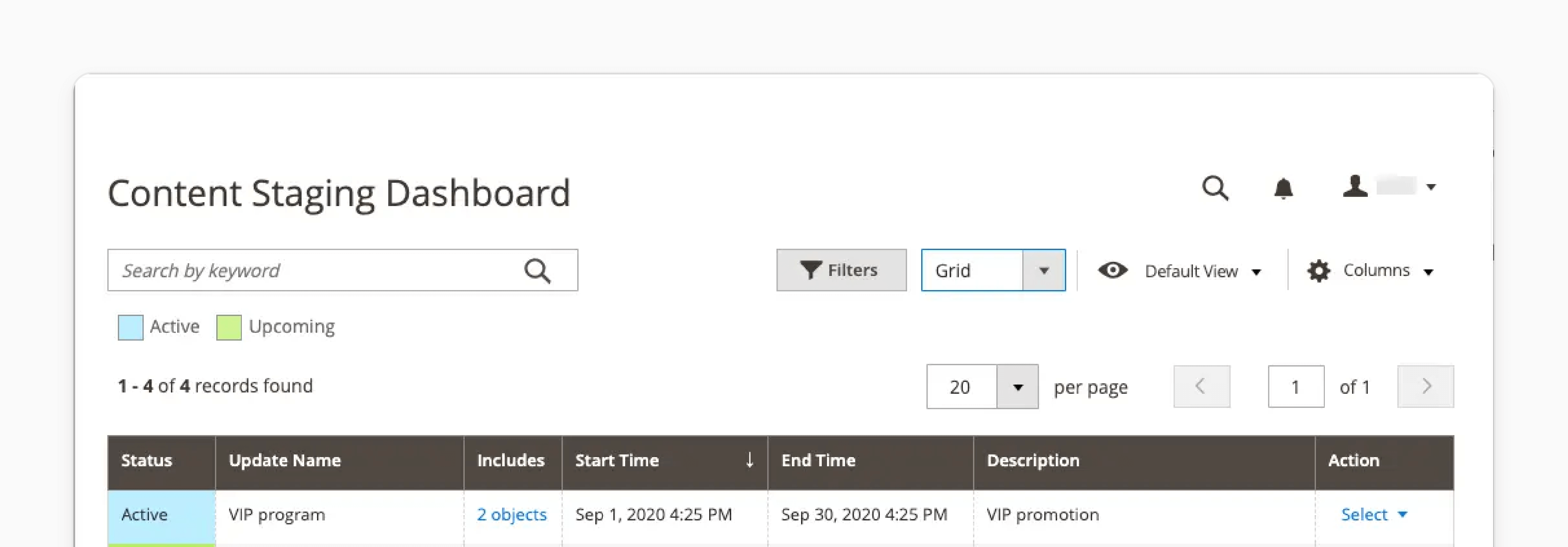
-
Store owners can use a content staging dashboard to set up and schedule updates. For example, a retailer is planning a holiday sale campaign. Using the content staging dashboard, they can:
-
Open the calendar view and select December 1st as the start date and December 31st as the end date.
-
Set specific times for the Magento sale to begin and end. It ensures the promotion starts at midnight and concludes at 11:59 PM on the last day.
-
Schedule multiple related updates within this timeframe. For instance, a user might plan for:
-
Product price changes to activate at the start of the sale.
-
A homepage banner update to go live simultaneously.
-
A last chance message to appear on December 30th.
-
The site to revert to its normal state on January 1st.
-
-
-
All of these changes can be prepared and scheduled in advance. It eliminates the need for manual updates during the busy holiday season.
-
The dashboard provides a visual timeline of all these scheduled changes. It allows the users to see at a glance how their site will evolve over the course of the campaign.
-
The level of marketing automation and organization saves time and reduces the risk of errors. It means a person can prepare everything in advance.
2. Staging Objects and Campaign Management
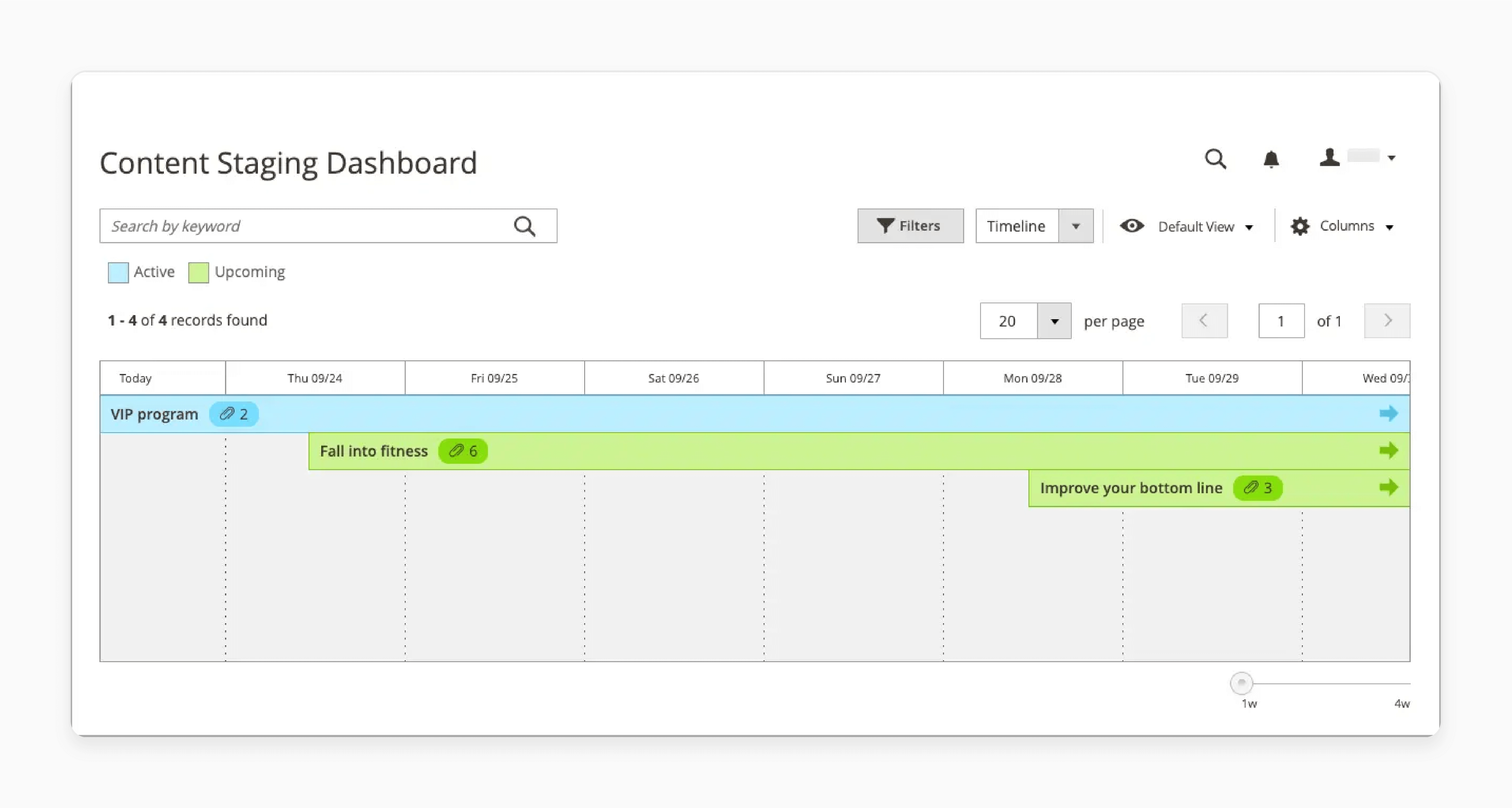
-
The dashboard gives a view of all the content staging objects and campaigns. The feature is particularly powerful for complex, multi-faceted marketing strategies.
-
Campaign Overview: The dashboard displays all active and upcoming campaigns in a timeline view. Each campaign can encompass multiple content changes across different areas of the site.
-
Granular Control: Within each campaign, one can manage individual staging objects. These might include:
-
Price rule changes
-
New product launches
-
Category restructuring
-
CMS page updates
-
-
Multi-store Management: For businesses running multiple store views, the dashboard allows to:
-
Magento Filter views by store or store group
-
Apply changes to specific stores
-
Compare scheduled changes across different store views
-
-
Interdependency Tracking: The system can highlight when scheduled changes might impact each other. For example, if a retailer schedules a category restructure. It would affect products involved in a planned promotion. The dashboard can alert them to the potential conflict.
-
-
Users can track or monitor them from a single interface. It helps to stay organized and manage different updates easily. This helps in handling various campaigns without missing important details.
3. Handling Baseline Content
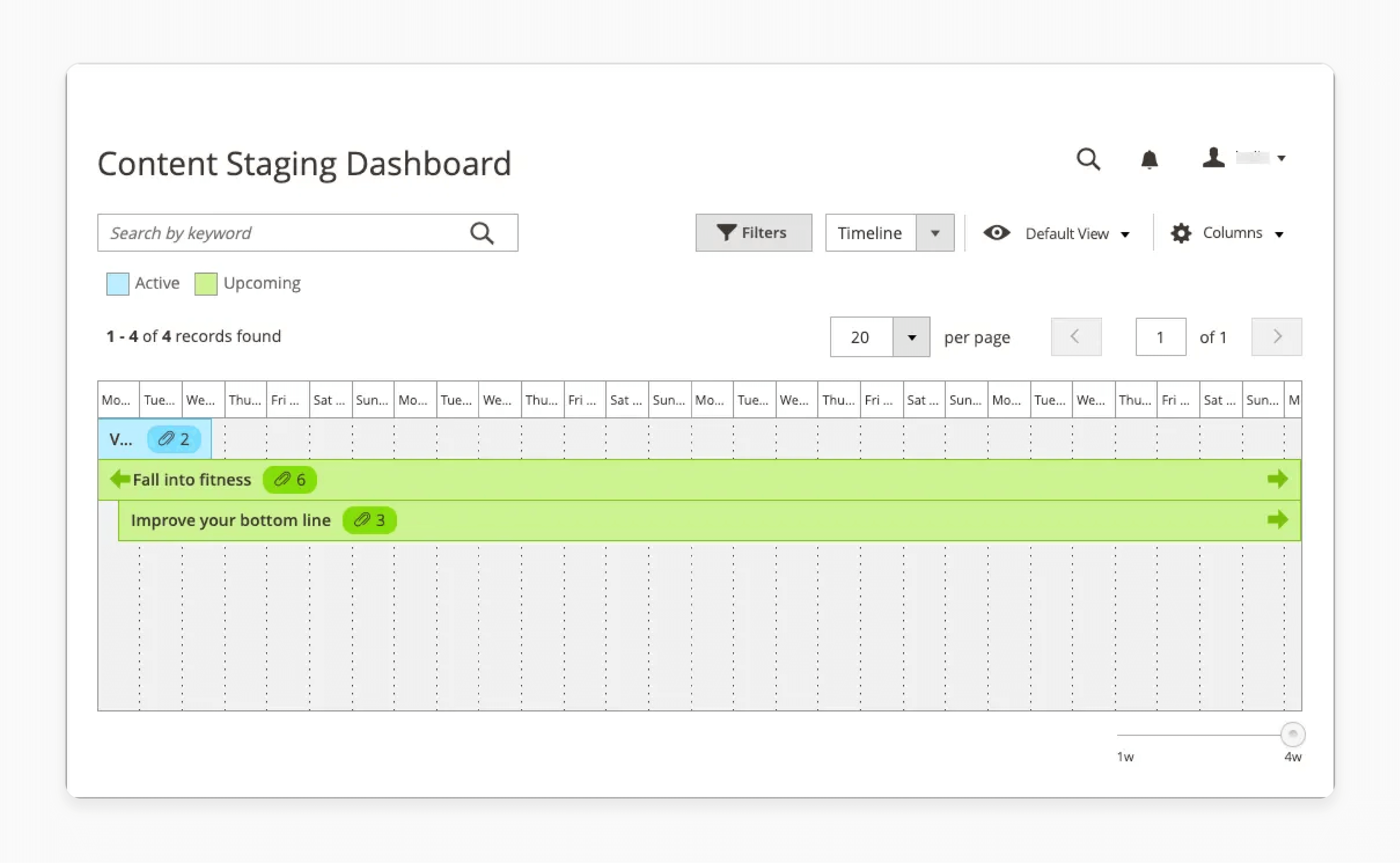
-
Baseline content refers to the default state of any content on the site. It applies when no scheduled changes are active. This includes product descriptions, category structures, and CMS page content.
-
Versioning System: When a user schedules a content change. Magento does not overwrite the baseline content. Instead, it creates a new version of the content. It then becomes active during the scheduled period.
-
Automatic Restoration: Once a scheduled change period ends. The system automatically reverts to the baseline content. It happens without any manual intervention required.
-
-
For example, a user has a product with a baseline description. Our classic t-shirt, made from 100% cotton, is available in multiple colors. For a summer sale, they schedule a change to this description: "Summer Sale! Our bestselling t-shirt is now 30% off.
-
The change is set to be active from June 1st to June 30th with:
-
Before June 1st: The baseline description is displayed.
-
June 1st to June 30th: The summer sale description is shown.
-
July 1st onwards: The system automatically reverts to the baseline description.
-
-
Suppose you decide to cancel the scheduled change midway through June. It can do so, and the baseline content will be immediately restored.
4. Tracking Active and Scheduled Campaigns
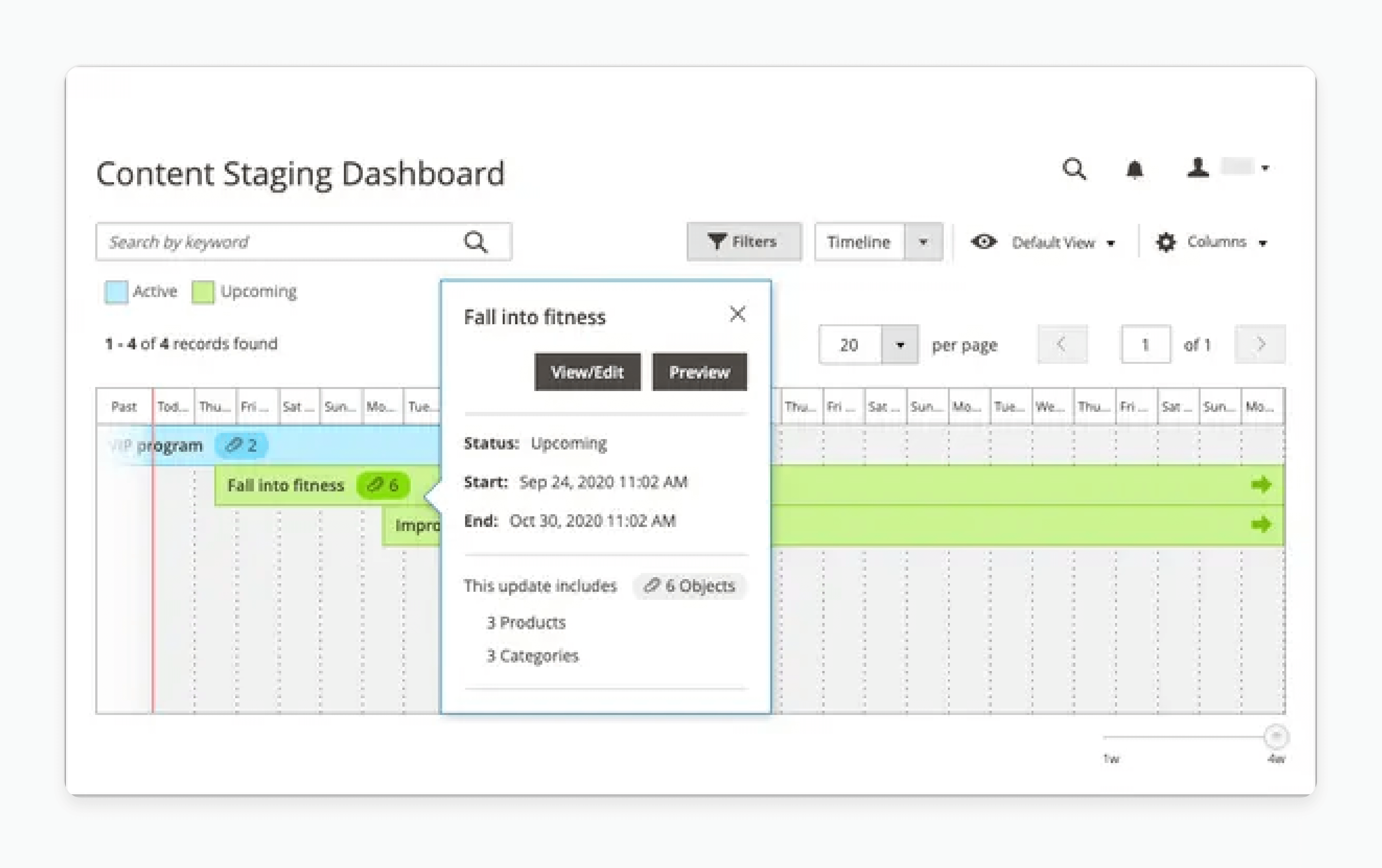
-
The ability to track active and scheduled campaigns is important. It maintains an organized and effective content strategy. They can also see a record of a scheduled change.
-
Magento's Content Staging provides enhanced tools for this purpose:
-
Magento Timeline View: At the top of the dashboard, all the active and upcoming campaigns are seen. Users can track the status of ongoing campaigns and plan new ones. The visual representation allows users to:
-
See the duration of each campaign
-
Identify any overlaps between campaigns
-
Spot gaps in the content calendar
-
-
Campaign Details: Clicking on any campaign in the timeline opens a detailed view. It shows:
-
All content changes associated with the campaign
-
Start and end dates/times for each change
-
The specific areas of the site affected
-
-
Filtering and Search: The dashboard includes powerful filtering and search capabilities. It allows the users to:
-
Filter campaigns by date range
-
Search for specific campaign names or associated content
-
View campaigns related to particular products or categories
-
-
Status Indicators: Each campaign is color-coded to indicate its status:
-
Green for active campaigns
-
Blue for upcoming campaigns
-
Gray for past campaigns
-
-
Change History: For each content item, users can view a history of all scheduled changes. It includes both the past and future. This helps in understanding how a particular piece of content has evolved over time.
-
-
For example, a user planning content for the next quarter. Using the tracking features, they can:
-
View all currently scheduled campaigns for the quarter.
-
Identify weeks where you have no content changes planned.
-
Spot any conflicts, such as overlapping price promotions.
-
Ensure that seasonal content (like holiday-themed banners) is scheduled. It appears and disappears at appropriate times.
-
Check that recurring events (like monthly newsletter updates) are correctly scheduled.
-
5. Previewing and Share Content
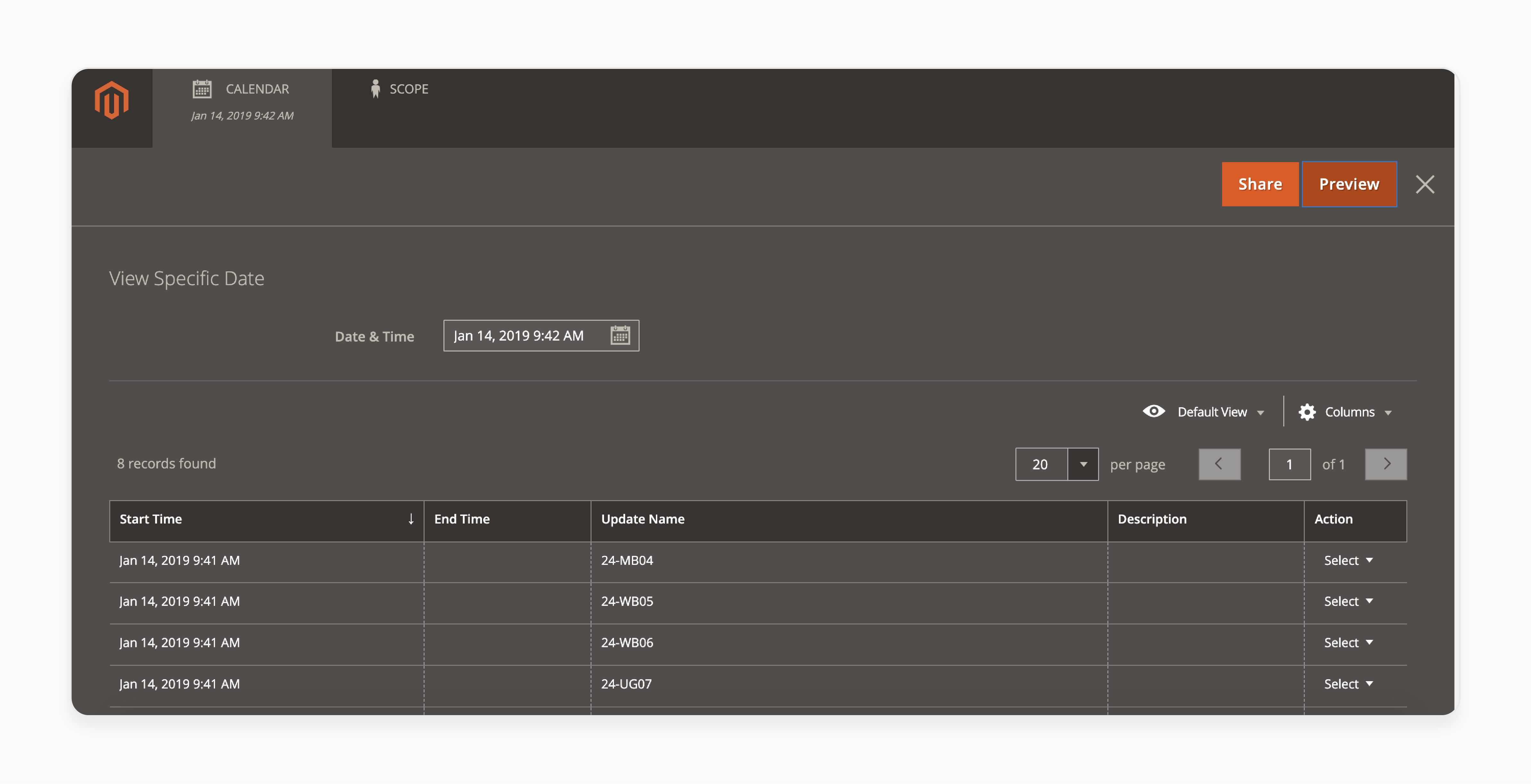
-
Before updates go live, store owners can preview them. It ensures they look and function as intended. Preview Functionality includes:
-
Full Site Preview: It activates when the preview mode is for a scheduled update. Users are presented with an interactive version when the update goes live.
-
Time-Travel Preview: It moves through the timeline to preview. It can be done on how the site will look at different points in the future. It takes into account all scheduled updates.
-
Device-Specific Preview: It previews the changes that appear on desktop, tablet, and mobiles.
-
Interaction Testing: In preview mode, users can interact with their site. It allows to test functionality like:
-
Product filters
-
Add-to-cart processes
-
Promotional code applications
-
-
Sharing Capabilities include:
-
Shareable Preview Links: It generates unique URLs. These links allow the stakeholders to view the preview without needing admin access.
-
Access Control: It sets expiration dates for preview links and controls. The recipient can only view or also leave comments.
-
Collaborative Annotation: Team members can leave comments directly on the preview. It pinpoints specific elements that need attention.
-
Version Comparison: It shares comparisons of the current live version and the update.
-
-
By utilizing these preview and sharing features, users can:
-
Catch and correct issues before they impact live customers.
-
Ensure consistency across all aspects of the site update.
-
Facilitate efficient collaboration among team members.
-
Gain confident stakeholder approval.
-
Reduce the risk of errors or oversights in content updates.
-
6. Managing Scheduled Modifications
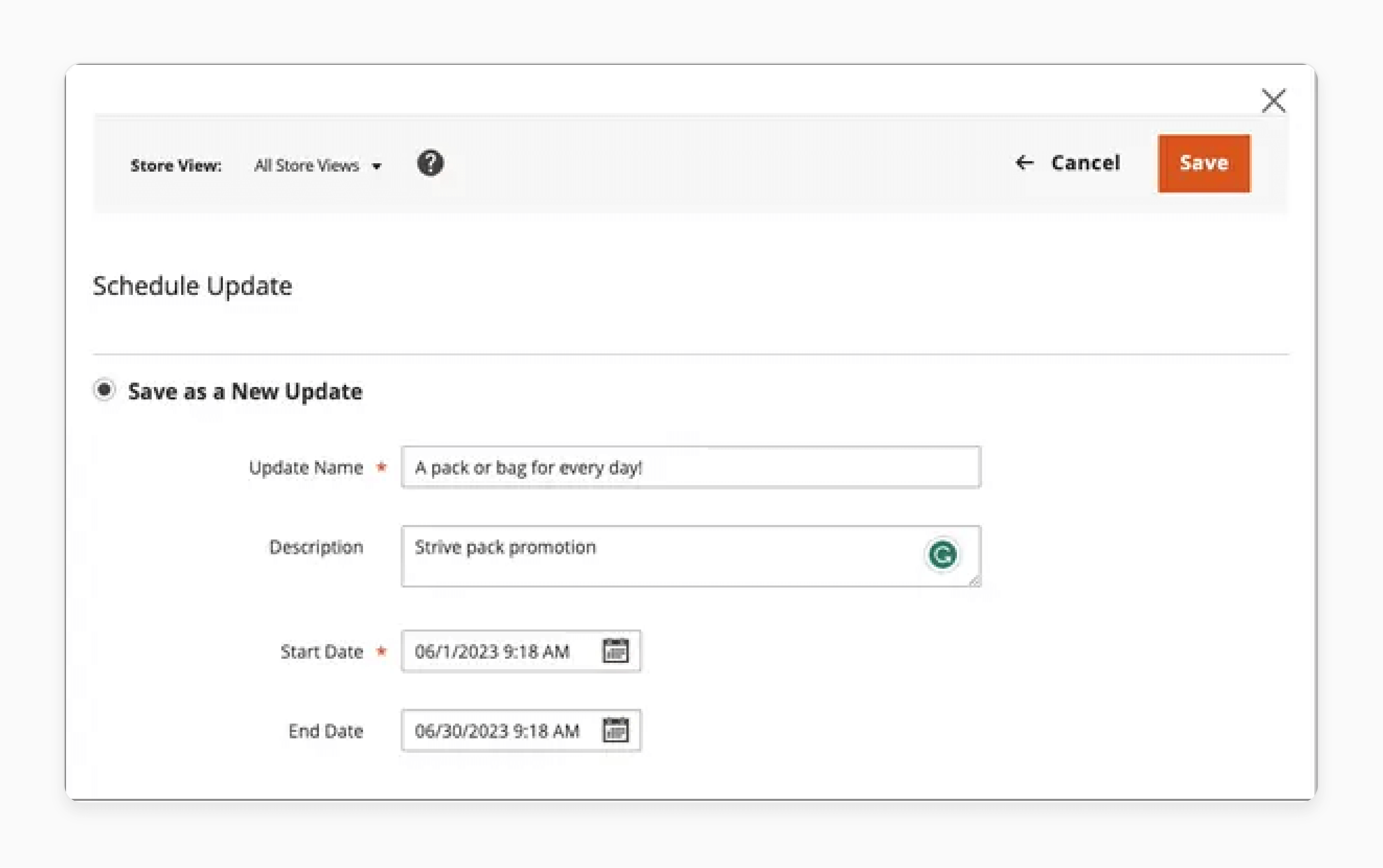
-
The scheduled changes section handles modifications for specific new campaigns for Magento ecommerce. It can choose to make the campaign open-ended by leaving the end date blank. The advanced management features include:
-
Conflict Resolution: The system alerts the potential conflicts between scheduled modifications. It includes overlapping price changes for the same product.
-
Dependency Chains: It create sequences of updates where one change triggers another.
-
Bulk Scheduling: To apply similar modifications for multiple products or categories.
-
Update Cloning: It duplicates successful campaigns or modifications for reuse.
-
-
It can also set exact start and end dates for updates. For example, if a user wants a product feature to run until stock runs out. They can schedule it without an end date. The flexibility helps to manage updates as needed.
How to Use Magento Content Staging in Adobe Commerce?
-
Magento Content Staging tool roll out changes to the ecommerce platform. It ensures a smooth experience for the customers. With Content Staging in Adobe Commerce, the Scheduled Changes box is key. It shows a timeline of all updates planned.
-
It helps teams work together better and see what changes are coming. It is great for planning marketing campaigns and content updates with precision. The baseline content is the core of the store.
-
It is used unless there is an active scheduled change for a certain time. The tool keeps the store consistent and fresh while users work on new content.
-
The timeline is displayed in the scheduled changes box helps the team work together. It gives great customer experiences. The use of Magento Content Staging in Adobe Commerce includes:
-
Use the scheduled changes box for a clear timeline of updates. It helps teams work together and be transparent.
-
Plan and preview changes carefully before they go live. It reduces the chance of mistakes.
-
Use content staging to schedule events and campaigns early. It gives users the time to get ready and execute well.
-
Keep the baseline content fresh and relevant. It is the solid base of Magneto's online presence.
-
| Content Staging Feature | Benefit |
|---|---|
| Scheduled Changes Box | Provides a visual timeline of all planned updates, enhancing collaboration and transparency. |
| Campaign with Scheduled Modifications | Enables businesses to plan and execute sales events and promotions in advance. |
| Preview Functionality | Allows teams to review and refine content modifications before the live store. |
| Baseline Content Management | Ensuring a consistent and engaging foundation as new content initiatives are deployed. |
Magento 2 Content Staging and Multi-Store Setups
Magento Content Staging lets retailers create unique experiences for different customers or regions. It can keep updates and campaigns in sync across all stores. Content Staging is great for managing content in a multi-store setup. It treats each store as its own entity. The feature means users can control products, categories, and more across stores. It is perfect for businesses with many stores. The staging helps to keep a consistent brand while targeting different audiences.
1. Managing Content Across Multiple Stores
Handling content across many stores can be tough. Magento Content Staging makes it easier for users to schedule updates across stores. The approach cuts down on work and helps avoid inconsistencies. For effective content management, having a clear strategy is key. Identify which content is shared and what is unique to each store. It helps in creating targeted campaigns that speak to the right audience at the right time.
2. Syncing Updates and Campaigns
Keeping updates and campaigns in sync is important with Magento Content Staging. Users can schedule updates to roll out at the same time across stores. This is important for campaigns like flash sales, where timing is everything. Content Staging also lets users test changes before they go live. It ensures updates work well across all stores. Testing in a staging environment helps catch issues early.
Best Practices for Optimizing Content Staging in Magento
| Best Practice | Details |
|---|---|
| Use the Content Staging Dashboard | The content staging dashboard provides a clear view of all the campaigns and updates. Track active campaigns and plan new updates to stay organized. |
| Track and Review Scheduled Changes | Keep an overview of all active and upcoming campaigns. The dashboard shows a timeline of scheduled changes and updates. It helps to review and adjust plans as needed. |
| Create and Manage Campaigns Efficiently | Create as many campaigns as needed with specific start and end dates. It makes them open-ended by leaving the end date field empty. Manage campaigns for the same asset effectively. |
| Preview Content Before Going Live | Preview updates before they go live to ensure they look right. This helps catch any issues early, such as with a static page or a new campaign. |
| Restore Baseline Content When Needed | The original baseline content is restored if you need to revert changes. The feature helps to experiment with confidence and return to the original content when needed. |
| Manage Store Object Updates | Use Magento's content staging to handle updates for various store objects. It includes catalog prices or site changes from one place. The updates are consistent and timely. |
| Schedule Content Updates Directly | Schedule updates directly from the backend panel. For example, set a catalog price change to go live on a specific date. Automate content changes to ensure timely updates. |
Upcoming Magento Content Staging Updates and Improvements
1. Enhanced Scheduling Features
-
Magento commerce will improve the scheduling of content updates. It allows retailers to set more accurate start and end dates. This means users can plan content changes with greater precision.
-
For example, scheduling a promotional campaign to start on a specific date and end on another. The enhancements will automate updates, reducing manual adjustments and ensuring timely content changes.
2. Improved Content Management
-
The new updates will enhance how users manage content staging objects and campaigns. Users will be able to handle various content updates more effectively.
-
It includes managing the collection of different elements of Magento store objects. For instance, updating catalog prices or creating new campaigns will be more simplified. It makes it easier to oversee multiple content elements.
3. Advanced Baseline Content Handling
-
Baseline content is restored easily with the help of Content staging improvements. If retailers experiment with different content, the process will be more smooth.
-
For example, suppose a person modifies a product description. Later, he wants to return to the original text. In that case, the system will handle the change, preserving the integrity of their content.
4. Better Preview and Sharing Options
-
New features will enhance how users preview and share content before they go live. This means they can review changes to static pages or promotional campaigns.
-
Sharing the updates with team members for feedback will be easier. It will help retailers catch any issues before their customers see the changes.
5. Expanded Dashboard Functionality
-
The content staging dashboard will offer improved visibility into all planned site changes. Users will have a clearer view of active and upcoming campaigns. It also includes better tracking of scheduled updates.
-
The enhanced timeline display will help users to manage and review content changes. It ensures users stay organized and on top of the page updates.
6. More Flexible Campaign Management
-
Upcoming updates will provide greater flexibility in managing campaigns. Retailers will be able to make campaigns open-ended by leaving the end date field empty.
-
The flexibility allows users to handle ongoing promotions or seasonal campaigns. It adjusts them as needed to fit their marketing strategy.
7 Troubleshooting Common Magento Content Staging Issues
| Common Issues | Troubleshooting Steps |
|---|---|
| Scheduled Updates Not Appearing | Set the desired start and end dates correctly. Check if the updates are scheduled at the right time. Verify this in the content staging dashboard. |
| Issues with Content Preview | If you face issues with previewing content. Ensure that the preview feature is correctly set up. Confirm that content is saved and scheduled properly before previewing. |
| Baseline Content Not Restoring | If the original baseline content is not restored. Check if content staging is properly configured. Review the record of scheduled changes and ensure that the restore feature is active. |
| Difficulty in Managing Multiple Campaigns | Use the staging dashboard to get an overview of all active and upcoming campaigns. Check the timeline and adjust campaigns to avoid conflicts and overlaps. |
| Campaigns Overlapping | To avoid overlapping, make sure each part of a campaign has unique start and end dates. Review the scheduled modifications for that specific campaign and adjust as necessary. |
| Changes Not Applied as Expected | Ensure that updates are directly applied to the store. Check the scheduled time and ensure that no active campaigns are interfering. Review the campaign settings for accuracy. |
| Content Updates Not Reflecting | Verify that the content updates are correctly scheduled. Check the changes box at the top of the admin panel. Ensure updates are correctly applied to the intended assets. |
FAQs
1. How can I schedule various content updates in Magento?
You can schedule various updates by setting the start date and end date for each campaign. The content staging dashboard provides tools to create a new scheduled update. It also manages campaigns with specific modifications. This allows you to organize updates for your store directly from the admin.
2. What should I do if the original baseline content is not restored?
If the original baseline content is not restored. Check the record of scheduled changes. Ensure that the feature of Magento is correctly set up. Restore baseline content whenever needed. Note that the baseline content is restored whenever all active campaigns end.
3. How do I manage content changes for a specific campaign?
Use the Magento content staging workflow feature. You can edit the content of an asset without affecting other campaigns. Review the timeline displayed in the content staging dashboard. Ensure updates are applied correctly.
4. How does Magento Content Staging handle a wide range of content updates?
Magento content staging allows for a wide range of content updates. It lets you schedule and manage various content elements. This includes updates for store objects, catalog changes, and site-wide modifications. The dashboard helps oversee all active and upcoming campaigns.
5. What is the role of the Magento admin in content staging?
The Magento admin panel is where you manage all content updates. It lets you schedule various content updates, view campaigns, and make changes directly. Use the admin panel to set up campaigns. Track modifications and review scheduled update for other objects.
6. How can I view and track scheduled updates?
You can view and track scheduled updates through the content staging dashboard. The timeline section at the top displays all active and upcoming campaigns. The feature helps you step back through the timeline. It also monitors scheduled modifications for other objects.
7. What should I do if I encounter issues with content staging?
Consult the user guide for troubleshooting tips. Ensure all elements that can be turned are scheduled properly. The baseline content is always restored. For specific issues, check the scheduled changes box. Review your settings to address any discrepancies.
Summary
Magento content staging simplifies managing and scheduling site content updates. It allows businesses to create campaigns, content changes, and view updates. It helps plan site changes and updates efficiently. The upcoming improvements of Magento content staging are:
-
Enhanced Scheduling Features
-
Improved Content Management
-
Advanced Baseline Content Handling
-
Better Preview and Sharing Options
-
Expanded Dashboard Functionality
-
More Flexible Campaign Management
Explore managed Magento hosting to enhance the ecommerce content for your store.






